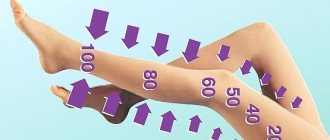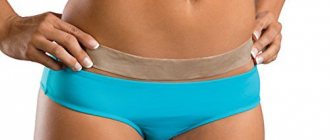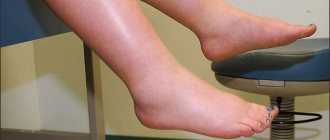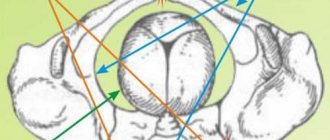Medical knitwear (compression underwear) is used in modern practice to treat varicose veins. An effective method for combating the disease at the initial stage of development, for prevention, for operations, and during the rehabilitation period. Often used for sports. Medical underwear distributes pressure evenly along the leg, aligns blood vessels, maintains their elasticity, and normalizes blood flow. Due to the compression class (pressure), it prevents pain and swelling at the end of the day as a result of physical activity on the limbs. Compression stockings for cesarean section are prescribed to patients to prevent thrombosis.
When a baby is born by caesarean section, the blood vessels are put under pressure. If a woman experienced problems with her veins during pregnancy and wore compression stockings, the doctor strongly recommends wearing stockings during surgery. During pregnancy there is a risk of developing thrombosis. Increased pressure on the lower extremities impedes the outflow of blood.
Caesarean sections are now becoming more common
Using compression garments, the doctor alleviates the patient’s condition. The use of medications to treat the disease is contraindicated and may harm the baby’s health. The use of medical knitwear in the initial stages of the development of varicose veins during pregnancy prevents the progression of the disease.
Selection rules
Before purchasing compression stockings, you should definitely consult a phlebologist. He will set the desired degree of compression, give the necessary recommendations and a table for determining the size of medical underwear.
In order to find out your size, you need to take a series of measurements (circumference of the hips, knees, legs and feet) and use the table to determine your size. The table is located on the packaging of the stockings and can also be found on the Internet.
Measurements should be taken in the morning, while the swelling is still mild, preferably in a supine position.
Compression stockings must have no seams. In addition, therapeutic underwear cannot be cheap; it is much more expensive than usual.
The composition of the product is very important; it is better to opt for stockings made from natural materials (cotton with rubber threads).
Quality compression stockings should last 6 to 10 months. Inspect the packaging, it should be marked (RAL), it guarantees the originality and quality of the medical linen.
Size
When purchasing products to prevent the appearance of varicose veins and swelling, you need to know its size. To do this you need to take measurements:
- girth of the upper thigh and its middle;
- circumference of the lower leg, knee, ankle;
- distance from foot to knee;
- distance from the foot to the top of the thigh.
You can take measurements yourself. But if they were prescribed in the last stages of pregnancy, difficulties may arise with the measurements, so it would be better if a phlebologist does this.
Why is the optimal size of knitwear that creates compression selected? Compression of the leg occurs gradually. Near the foot it is strengthened, but the closer to the thigh, the weaker it is. This promotes good blood circulation and prevents congestion in the veins. The packaging of medical underwear indicates all the parameters for the correct selection.
Read also: Is it possible to get pregnant after childbirth if you don’t have periods?
If a girl has long graceful legs with feet measuring 38-39 cm, she will need size S. For those with feet 34-36 cm, this size will be uncomfortable. Knitwear with open toes is practical.
Putting on stockings correctly
Compression stockings have their full effect on the risk area only if the underwear is worn correctly. The procedure for putting on medical knitwear is as follows: in the morning, without getting out of bed or a bed in the hospital, after removing the jewelry on your fingers and toes, gather the stocking into an accordion. Insert your hand into the hole of the product, and then put the stocking on your foot, firmly fixing it in the area of the toes and heel. Gradually pull the stocking up to the ankle or thighs, if necessary, stretch the product higher. The procedure for pulling on compression stockings is greatly facilitated by the use of silk socks or gloves. Also an integral device in the process of putting on underwear among obese patients is the butler, designed to simplify the procedure for placing stockings on the leg.
Purpose of compression garments
During the birth of a baby, the mother’s body experiences enormous stress, during which the pressure on the vascular structures becomes prohibitive. Therefore, experts recommend wearing compression stockings during a caesarean section. But even before giving birth, if vascular stars are discovered, veins begin to bulge and stand out brightly, and you constantly feel tired in your legs, then you need to consult a phlebologist. The specialist will select underwear with the necessary compression and determine the mode of wearing it.
Indications for wearing compression stockings are:
- Bleeding disorders;
- Presence of extra pounds;
- Age after 35th birthday;
- Diabetes, etc.
Stockings will also help those who often notice swelling in their legs or suffer from cramps in their limbs. Such manifestations are also frequent companions of pregnancy. The compression effect is achieved through different pressures on individual parts of the limb. From below and to the knee, the product tightens the leg with greater compression than in the hip area. Until recently, elastic bandages were used for the compression effect, but with the advent of compression stockings, the problem of ease of use and effectiveness was solved, since the stockings correctly encircle the limb and putting them on is much easier than wrapping yourself in bandages.
Compression products will also help when carrying a baby, as they eliminate a variety of negative symptoms that appear during this period. Such manifestations include swelling and convulsive attacks in the limbs, asterisks or a constant feeling of fatigue in the limbs. The use of medical underwear will lighten the load and help prevent the occurrence of all kinds of complications. Of course, you won’t be able to completely protect yourself from varicose veins and birth problems with stockings alone, but they significantly increase the possibility of maintaining the health of your legs and vascular system during this time.
Putting on stockings correctly
Compression stockings have their full effect on the risk area only if the underwear is worn correctly. The procedure for putting on medical knitwear is as follows: in the morning, without getting out of bed or a bed in the hospital, after removing the jewelry on your fingers and toes, gather the stocking into an accordion. Insert your hand into the hole of the product, and then put the stocking on your foot, firmly fixing it in the area of the toes and heel. Gradually pull the stocking up to the ankle or thighs, if necessary, stretch the product higher. The procedure for pulling on compression stockings is greatly facilitated by the use of silk socks or gloves.
Also an integral device in the process of putting on underwear among obese patients is the butler, designed to simplify the procedure for placing stockings on the leg.
Doctors recommend wearing underwear made from compression knitwear into everyday life not only for people who have undergone various types of operations; this product will become a real friend for those whose lifestyle is characterized by such features as wearing high heels, spending most of the day in a sitting position, serious load on the lower limbs. By the way, compression underwear is rightfully considered a universal preventive measure for varicose veins, swelling, heaviness and pain in the legs among representatives of not only women, but men. Health has no gender boundaries!
People who are forced to use compression stockings due to health conditions speak positively about knitted products that help improve blood circulation: they note that the beneficial effect of stockings on health occurs during the first days of wearing. Comfort, slimness and endurance of the legs - this is what hosiery made from compression hosiery gives to those who use this type of therapeutic underwear.
The main thing is to give preference to products made from natural fabrics in your choice, choose an option with the optimal pressure category and the required size (it is recommended to resolve this issue in consultation with your doctor) and follow the rules for wearing anti-embolic underwear.
How many days are they safe to use?
To maintain the health of your legs, it is not enough to simply wear stockings during the operation; you need to wear them for several days after it. A phlebologist or operating gynecologist can tell you how much to wear knitwear in each individual case. Most often, a woman is contraindicated to remove anti-embolic surgical stockings for 2-3 days after the operation, until she can move relatively normally, blood flow in the legs has been restored, and the negative effects of anesthesia have finally passed. After this, you can no longer wear special stockings, but return to the regular knitwear that was used during pregnancy. It is recommended to wear these products for another 2-3 months after birth. After this time, the woman’s body is restored, the venous and circulatory system returns to its original form and the need to support the veins from the outside disappears.
This video will help you understand the issue in more detail:
Gynecologists do not always tell pregnant women that special underwear must be used to ease the stress on the legs during pregnancy, as well as to prevent thromboembolism during surgical childbirth. Compression stockings for caesarean section perform extremely important functions, preventing the development of thrombosis during surgery. Who needs to wear such underwear for surgery, why, how long to wear it - these questions most often interest mothers.
Wearing during pregnancy
During pregnancy, your doctor may also recommend wearing compression stockings in the later stages, when your body weight increases significantly. As a rule, this indicates that complications may develop that may require a caesarean section. How long to wear compression stockings after cesarean section in this case again depends on the characteristics of the course of pregnancy. In early pregnancy, healthy patients usually do not need to wear compression stockings.
How much to wear
It is recommended to start wearing stockings before delivery. Experts recommend that you wear compression garments for at least a week, removing them at night. Childbirth usually also takes place in stockings. If the doctor says that you need to wear such stockings, then you need to follow these recommendations. Thrombosis is a dangerous pathology in which a formed blood clot interferes with blood circulation. The consequences of such a phenomenon can be very sad.
A blood clot can break off and begin to “travel” through the artery of the lung; this form is considered the most dangerous. Therefore, you should not risk your own life, it is better to listen to a doctor and walk for the necessary time in compression garments. When a woman is carrying a baby, blood clotting increases, which seriously increases the likelihood of thrombosis.
Some try to replace anti-embolic stockings with bandages, however, experts do not recommend doing this at all. Not only are such bandages not entirely comfortable, since during movements they slip and weaken, unwind and gather into an accordion. In addition, such bandages put uneven pressure on the legs, pinching those parts where it is not at all necessary, and can cause harm. And the use of stockings ensures the necessary pressure distribution.
Compression stockings for childbirth: how to choose size and compression?
There are several criteria for choosing compression stockings. They are divided by classes, types and sizes. And in order for the expectant mother to feel good and for the birth to take place without dangerous consequences, you need to choose these stockings correctly.
First of all, you should pay attention to the class of such compression knitwear. This important parameter can only be selected by a specialist. Therefore, before purchasing such stockings, consult a phlebologist and ask him to choose the right class.
Measurement locations
There are four classes of such stockings:
- Class 1. These stockings provide 23 mmHg compression. The specialist recommends them for slightly enlarged veins, the appearance of spider veins and heaviness in the legs at the end of the working day.
- Class 2. These stockings are capable of creating a compression of 33 mmHg. They are recommended for manifestations of varicose veins and thrombophlebitis.
- Class 3. These stockings create a compression of 45 mmHg. Prescribed for severe forms of venous insufficiency.
- Class 4. Stockings with pressure over 50 mmHg. Prescribed for severe swelling and disturbances in lymph flow.
All of the above classes belong to medical knitwear. But there are also preventive stockings that a gynecologist can recommend if you are at risk of developing the diseases described above.
Compression underwear
Compression garments are divided into three types: stockings, tights and knee socks. Each of them has its own pros and cons:
- Knee socks. This type of compression garment is prescribed if only the calf part of the legs is affected. Compression socks are indicated for cramps, pain and varicose veins in the specified area. They can be used if the lesions are below the hips.
- Stockings. Of all the compression garments, stockings are the most popular. Especially when it comes to pregnant women. This type of compression hosiery is used if the problem affects not only the calf, but also the thighs.
- Tights. If the thighs are affected, tights can also be used. But they put a lot of pressure on the stomach. This means their use is contraindicated during pregnancy.
How to put on stockings
In addition to the types and classes of such compression underwear, when choosing it, you need to take into account the size. To do this, before purchasing you need to measure:
- Volume of the lower leg (measured under the ankle)
- Volume of the upper leg (measured below the knee)
- Thigh circumference (measured 25-30 cm from the knee)
- Leg length (from the bottom point to the hip measurement point)
If you choose tights rather than stockings, then you need to add the waist and hip circumference to these indicators.
The data obtained after such measurements must be compared with the data in this table:
You can also simply transfer them to a sales consultant in a specialized salon, pharmacy or online store. He will choose the size that will be comfortable for you.










